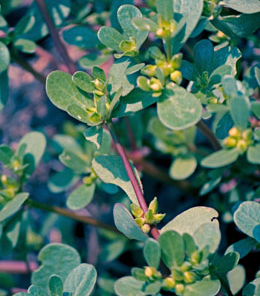Many people often wonder if purslane is a weed or an edible plant. Although an invasive weed, it often finds its way into salads and other recipes. Let us take a look at the care that is necessary for this plant in the following article.

You may have observed a thick, fleshy weed with a reddish stem growing in your garden. If you observe it closely, you will find that this weed grows close to the ground and there are roots growing near its nodes. Purslane tends to grow between cracks on walls and forms a thick mat across the ground. These succulent weeds are often considered invasive and their seeds can survive for up to 5 years. Their flowers produce seeds in a week or so after they bloom. So, even if you get rid of the plant, the seeds will continue to grow and multiply. On the brighter side, this plant is rich in vitamins and minerals. There are many recipes that use this plant which include salads, stews, and soups.
Information
You can distinguish purslane from other weeds because of its smooth, reddish prostrate stems. The leaves are alternate and clustered at stem joints. It produces yellow flowers after rainfall. The seeds develop in a tiny pod and disperse when ready. This houseplant has a tap-root system with fibrous roots. This helps the plant survive through droughts, compact soil, as well as poor soil conditions. This plant is native to India and is believed to have spread to other areas of the world during its colonization. In United States, it is considered an exotic weed and is cultivated as a food crop.
Care
It has the ability to survive droughts and tolerates warm temperatures. It can thrive in almost any type of soil from poor soil to loamy garden soil, and even rocky soil. You can bring home seeds and sow them in your garden. Do not press the seeds deep within the soil. Plant them near the surface as they will not germinate if kept more than ½ inch below the soil. After about two weeks the seeds will germinate. They grow best in warm summer months.
In summer, you need to water the plants once a week, especially, if there is no rainfall. These plants are succulent and can survive long periods without water. You can harvest the plant within 6 weeks of planting them.
In case, your plant turns invasive, you need to carry out weed control. You should pull out young tender plants. This is because it is easier to pull out young plants as compared to mature ones. Remove the entire plant, as it has the ability to propagate from stems. You can use a herbicide if the growth of the weed gets out of hand. Use organic herbicides like acetic acid and clove oil as they will not harm neighboring plants.
A highly nutritious plant, it contains vitamin A, vitamin C, vitamin B, and carotenoids. It is full of essential minerals like magnesium, calcium, potassium, and iron. It also contains high levels of omega-3 fatty acids and beta carotene. You can use it in your food to increase the nutritional content of your diet.






 You may have observed a thick, fleshy weed with a reddish stem growing in your garden. If you observe it closely, you will find that this weed grows close to the ground and there are roots growing near its nodes. Purslane tends to grow between cracks on walls and forms a thick mat across the ground. These succulent weeds are often considered invasive and their seeds can survive for up to 5 years. Their flowers produce seeds in a week or so after they bloom. So, even if you get rid of the plant, the seeds will continue to grow and multiply. On the brighter side, this plant is rich in vitamins and minerals. There are many recipes that use this plant which include salads, stews, and soups.
You may have observed a thick, fleshy weed with a reddish stem growing in your garden. If you observe it closely, you will find that this weed grows close to the ground and there are roots growing near its nodes. Purslane tends to grow between cracks on walls and forms a thick mat across the ground. These succulent weeds are often considered invasive and their seeds can survive for up to 5 years. Their flowers produce seeds in a week or so after they bloom. So, even if you get rid of the plant, the seeds will continue to grow and multiply. On the brighter side, this plant is rich in vitamins and minerals. There are many recipes that use this plant which include salads, stews, and soups.